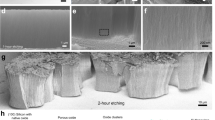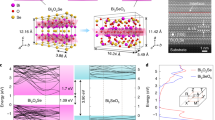Abstract
The operation of electronic devices relies on the density of free charge carriers available in the semiconductor; in most semiconductor devices this density is controlled by the addition of doping atoms. As dimensions are scaled down to achieve economic and performance benefits, the presence of interfaces and materials adjacent to the semiconductor will become more important and will eventually completely determine the electronic properties of the device. To sustain further improvements in performance, novel field-effect transistor architectures, such as FinFETs1,2 and nanowire field-effect transistors3,4,5,6,7, have been proposed as replacements for the planar devices used today, and also for applications in biosensing8,9,10 and power generation11. The successful operation of such devices will depend on our ability to precisely control the location and number of active impurity atoms in the host semiconductor during the fabrication process. Here, we demonstrate that the free carrier density in semiconductor nanowires is dependent on the size of the nanowires. By measuring the electrical conduction of doped silicon nanowires as a function of nanowire radius, temperature and dielectric surrounding, we show that the donor ionization energy increases with decreasing nanowire radius, and that it profoundly modifies the attainable free carrier density at values of the radius much larger than those at which quantum12,13 and dopant surface segregation14 effects set in. At a nanowire radius of 15 nm the carrier density is already 50% lower than in bulk silicon due to the dielectric mismatch15 between the conducting channel and its surroundings.
This is a preview of subscription content, access via your institution
Access options
Subscribe to this journal
Receive 12 print issues and online access
$259.00 per year
only $21.58 per issue
Buy this article
- Purchase on Springer Link
- Instant access to full article PDF
Prices may be subject to local taxes which are calculated during checkout




Similar content being viewed by others
References
Hisamoto, D., Kaga, T. & Takeda, E. Impact of the vertical SOI ‘DELTA’ structure on planar device technology. IEEE Trans. Electron. Dev. 38, 1419–1424 (1991).
Hisamoto, D. et al. A folded-channel MOSFET for deep-sub-tenth micron era. IEDM Tech. Dig. 1032–1034 (1998).
Suk, D. S. et al. High performance 5 nm radius twin silicon nanowire MOSFET(TSNWFET): Fabrication on bulk Si wafer, characteristics and reliability. IEDM Tech. Dig. 717–720 (2005).
Singh, N. et al. High-performance fully depleted silicon nanowire (diameter ≤5 nm) gate-all-around CMOS devices. IEEE Electron. Dev. Lett. 27, 383–386 (2006).
Xiang, J. et al. Ge/Si nanowire heterostructures as high-performance field-effect transistors. Nature 441, 489–493 (2006).
Cohen, G. M. et al. Nanowire metal-oxide-semiconductor field effect transistor with doped epitaxial contacts for source and drain. Appl. Phys. Lett. 90, 233110 (2007).
Thelander, C., Fröberg, L. E., Rehnstedt, C., Samuelson, L. & Wernersson, L.-E. Vertical enhancement-mode InAs nanowire field-effect transistor with 50 nm wrap gate. IEEE Electron. Dev. Lett. 29, 206–208 (2008).
Cui, Y., Wei, Q., Park, P. & Lieber, C. M. Nanowire nanosensors for highly sensitive and selective detection of biological and chemical species. Science 293, 1289–1292 (2001).
Zheng, G., Patolsky, F., Cui, Y., Wang, W. U. & Lieber, C. M. Multiplexed electrical detection of cancer markers with nanowire sensor arrays. Nature Biotechnol. 23, 1294–1301 (2005).
Stern, E. et al. Label-free immunodetection with CMOS-compatible semiconducting nanowires. Nature 445, 519–522 (2007).
Boukai, A. I. et al. Silicon nanowires as efficient thermoelectric materials. Nature 451, 168–171 (2008).
Bryant, G. W. Hydrogenic impurity states in quantum-well wires. Phys. Rev. B 29, 6632–6639 (1984).
Khanal, D. R., Yim, J. W. L., Walukiewicz, W. & Wu, J. Effects of quantum confinement on the doping limit of semiconductor nanowires. Nano Lett. 7, 1186–1190 (2007).
Fernandez-Serra, M. V., Adessi, Ch. & Blase, X. Surface segregation and backscattering in doped silicon nanowires. Phys. Rev. Lett. 96, 166805 (2006).
Diarra, M., Niquet, Y.-M., Delerue, C. & Allan, G. Ionization energy of donor and acceptor impurities in semiconductor nanowires; importance of dielectric confinement. Phys. Rev. B. 75, 045301 (2007).
Schechter, D. Shallow impurity surface states in silicon. Phys. Rev. Lett. 19, 692–693 (1967).
Niquet, Y. M. et al. Electronic structure of semiconductor nanowires. Phys. Rev. B 73, 165319 (2006).
Schmidt, V., Senz, S. & Gösele, U. Influence of the Si/SiO2 interface on the charge carrier density of Si nanowires. Appl. Phys. A. 86, 187–191 (2007).
Cui, Y. et al. Diameter-controlled synthesis of single-crystal silicon nanowires. Appl. Phys. Lett. 78, 2214–2216 (2001).
Schmidt, V., Senz, S. & Gösele, U. Diameter-dependent growth direction of epitaxial silicon nanowires. Nano Lett. 5, 931–935 (2005).
Angermann, H., Dittrich, Th. & Flietner, H. Investigation of native-oxide growth on HF-treated Si(111) surfaces by measuring the surface-state distribution. Appl. Phys. A 59, 193–197 (1994).
Okorn-Schmidt, H. F. Characterization of silicon surface preparation processes for advanced gate dielectrics. IBM J. Res. Develop. 43, 351–365 (1999).
Jin, S., Fiscetti, M. V. & Tan, T.-V. Modeling of electron mobility in gated silicon nanowires at room temperature: surface roughness scattering, dielectric screening and band nonparabolicity J. Appl. Phys. 102, 083715 (2007).
Ramayya, E. B., Vasileska, D., Goodnick, S. M. & Knezevic, I. Electron transport in silicon nanowires: The role of acoustic phonon confinement and surface roughness scattering. J. Appl. Phys. 104, 063711 (2008).
Hiramoto, T., Saitoh, M. & Tsutsui, G. Emerging nanoscale silicon devices taking advantage of nanostructure physics. IBM J. Res. Develop. 50, 411–418 (2006).
Schenk, A., Altermatt, P. P. & Schmithusen, B. Physical modeling of incomplete ionization for silicon device simulation. International Conference on Simulation of Semiconductor Processes and Devices, 51–54 (IEEE, 2006).
Schmid, H. et al. Patterned epitaxial vapor–liquid–solid growth of silicon nanowires on Si(111) using silane. J. Appl. Phys. 103, 024304 (2007).
Irvin, J. C. Resistivity of bulk silicon and of diffused layers in silicon. Bell Syst. Technol. J. 41, 387–391 (1962).
Acknowledgements
The authors acknowledge fruitful discussions with P. Solomon, S. Karg, D. Webb and R. Stutz. This work was partially supported by the European Union (NODE 015783).
Author information
Authors and Affiliations
Corresponding author
Supplementary information
Supplementary Information
Supplementary Information (PDF 844 kb)
Rights and permissions
About this article
Cite this article
Björk, M., Schmid, H., Knoch, J. et al. Donor deactivation in silicon nanostructures. Nature Nanotech 4, 103–107 (2009). https://doi.org/10.1038/nnano.2008.400
Received:
Accepted:
Published:
Issue Date:
DOI: https://doi.org/10.1038/nnano.2008.400
This article is cited by
-
Classification with a disordered dopant-atom network in silicon
Nature (2020)
-
Features of electron gas in InAs nanowires imposed by interplay between nanowire geometry, doping and surface states
Scientific Reports (2017)
-
Modulation Doping of Silicon using Aluminium-induced Acceptor States in Silicon Dioxide
Scientific Reports (2017)
-
Tunneling in Systems of Coupled Dopant-Atoms in Silicon Nano-devices
Nanoscale Research Letters (2015)



